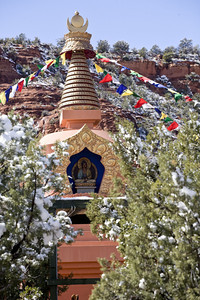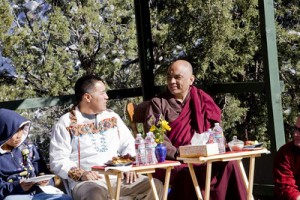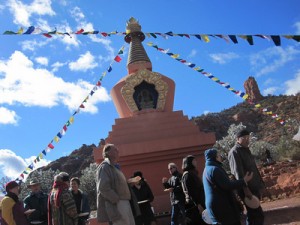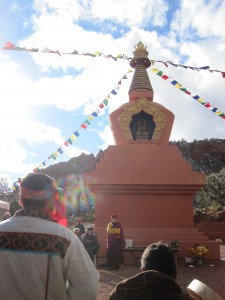At the invitation of Jetsunma Ahkön Lhamo, Khenpo Tenzin Norgay was in Sedona the weekend of February 25-27 for several events, including an Amitabha empowerment at KPC’s Amitabha Stupa, several talks on the significance of the stupa and the sacred land upon which it is built, and even a guest appearance at the Sedona International Film Festival to answer questions at the screening of a documentary movie called Journey from Zanskar: A Monk’s Vow to Children. The weekend’s events were a great success, drawing large audiences despite the chilly February weather and the competition of the film festival. But the event at the stupa on Sunday, February 27th, provided a special treat to those who braved the elements.
Sunday – Dakini Day – dawned to a world of white with fluffy fresh snow blanketing the town and the red rocks. Such a snow is considered a blessing by Tibetans, but it seemed an inauspicious start to a day that was planned to feature a talk by Khenpo at the stupa and a song offering by Hopi Indians. It appeared that the Hopi would not be able to make it to Sedona as all roads leading from the Flagstaff area were closed. In addition, the wet, rapidly melting snow had turned the dirt road leading up to the stupa into a quagmire. This meant that no vehicles would be able to drive to the stupa to carry heavy equipment like a PA system or a generator to power the planned webcast. In view of the situation, it was decided to change the schedule and replace the planned talk with a Shower of Blessings practice, which is the heart practice at KPC, and including a sang (smoke) offering to purify negativity.
By 2:00 the warm sun had melted much of the snow, and the clouds had long since abandoned the sky to the brilliant Arizona sun. A group of about thirty people had assembled, many of whom had never participated in any kind of Tibetan Buddhist practice. Partway through the practice, to everyone’s surprise, word arrived that the Hopis were indeed on their way and were expected shortly. The practice was speeded to finish by the time they arrived. As people were enjoying the food offering that is a part of the practice, Ruben Saufkie Sr. came walking up the hill with his two young sons. They were seated on the stage next to Khenpo, and Ruben and Khenpo talked for several minutes. People were invited to come and sit close to the stage, and Ruben then repeated what he had shared with Khenpo.
Ruben said that he personally had been out of balance for many years, caught up in the throes of alcoholism, disrespectful to everyone, out of control. But then he looked into the eyes of his children and recognized the same look of fear and hopelessness that he had experienced as a child, for both his father and grandfather had also been alcoholics. This realization caused him to reexamine his life as a father and as a Hopi. His Hopi elders gave him the teachings to help him overcome his addictions and to return to balance. As he emerged from his addictions, he also began to see how the Hopis as a tribe were also out of balance and that this was destroying them. The population has shrunk to a mere 13,000, and out of over a hundred clans, only less than thirty survive. Disagreements between individual Hopis and Hopi villages abound on how the Hopi nation should cope with the modern world. What Ruben came to realize was that Hopis should return to their original teachings of how to live life in balance, that they needed to move out of their egos and return to their hearts as this was the seat of power and balance.
Ruben’s mission now, as he explained, was to do everything he could to restore this balance, both in the Hopi nation and the world. He said he began with his own life and family, and that he was now reaching out to his fellow Hopi and to those beyond the reservation. This has often resulted in attacks by other Hopis, accusing him of just pursuing money, consorting with non-Hopis, and not caring about his people. Ruben said that this has been very painful for him and there have been times when he has felt like abandoning his mission. When he received the invitation to come to Sedona to participate in the events with Khenpo, however, he felt like a new door had been opened, and his enthusiasm to continue was renewed. On Sunday morning he saw the snow and heard the traffic reports, but he felt certain that this meeting was meant to happen, so he set out. As he and his sons approached Flagstaff, a pure white hawk flew directly over his car, so he felt certain that everything would be auspicious. And indeed, I-17 was reopened by the time he got to Flagstaff, and he was able to safely drive down the mountain to Sedona.
Ruben then talked about the location of the stupa and explained how this area had been known to his people long ago. They thought it was extraordinarily beautiful, but they chose not to live there because they knew that someday someone would take the land from them for its beauty. After a short stay, they proceeded on their way to their permanent home on the Hopi Mesas, which are shaped like a hand. He said that building a stupa in this place is a wonderful way to honor its sacredness.
Then Ruben and his sons donned their traditional Hopi dress and prepared to sing. First Ruben blessed the stupa, Khenpo, and the audience with condor and eagle feathers, representing the 500 year-old prophecy of the coming together of the ancient teachings of the North (eagle) with those of the South (condor) – in other words, the joining of the ancient wisdom of the Indian tribes of the North, such as the Hopi, with those of the South, the Incas, Aztecs, Mayas. Then he and his sons formally introduced themselves, first in Hopi, then in English. They proceeded to sing several traditional Hopi songs dedicated to bear, deer and other native animals, accompanied by drum and rattle. The songs evinced the beauty of the high windswept mesas where the Hopi found their permanent home, evoking a feeling of ancient wisdom and a connection to the earth that has been largely lost in our modern, hyperactive world.
Several photographs taken at the time of the songs reveal miraculous images of rainbow light and bindus – small orbs of energy which, according to Khenpo (who took the picture seen here), are signs of the auspiciousness of the two traditions coming together. Jetsunma, who followed the day’s events closely via texting and photographs, added, “Here are two Ancient Tribes returning.” She went on to say, “This is so auspicious!!! I cannot tell you!”
The ancient prophecies are coming true before our eyes. EH MA HO!
This article was written by Thubten Palzang















What an amazing photo of the rainbow lights!
It’s great to hear the whole story!